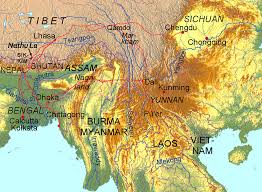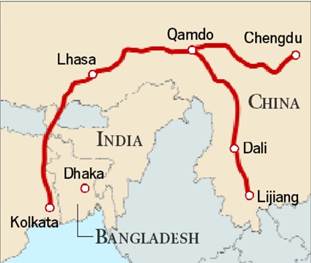- Courses
- GS Full Course 1 Year
- GS Full Course 2 Year
- GS Full Course 3 Year
- GS Full Course Till Selection
- Answer Alpha: Mains 2025 Mentorship
- MEP (Mains Enrichment Programme) Data, Facts
- Essay Target – 150+ Marks
- Online Program
- GS Recorded Course
- Polity
- Geography
- Economy
- Ancient, Medieval and Art & Culture AMAC
- Modern India, Post Independence & World History
- Environment
- Governance
- Science & Technology
- International Relations and Internal Security
- Disaster Management
- Ethics
- NCERT Current Affairs
- Indian Society and Social Issue
- NCERT- Science and Technology
- NCERT - Geography
- NCERT - Ancient History
- NCERT- World History
- NCERT Modern History
- CSAT
- 5 LAYERED ARJUNA Mentorship
- Public Administration Optional
- ABOUT US
- OUR TOPPERS
- TEST SERIES
- FREE STUDY MATERIAL
- VIDEOS
- CONTACT US
Tea Horse Road: The Historic Trade Route Connecting India and China
Tea Horse Road: The Historic Trade Route Connecting India and China

- In February, 2025 China’s Ambassador to India, Xu Feihong, highlighted the significance of the ancient Tea Horse Road, a trade route spanning over 2,000 km that historically connected China to India via Tibet.
- Although less renowned than the Silk Road, this route played a crucial role in commerce and cultural exchange for centuries, facilitating the trade of tea, horses, and other valuable goods across challenging terrains.
Origins and Development
- The origins of the Tea Horse Road date back to the Tang Dynasty (618-907 CE) when trade between Southwest China, Tibet, and India flourished.
- Buddhist monk Yijing (635-713 CE) documented early trade exchanges, mentioning goods such as sugar, textiles, and rice noodles moving from China, while horses, Tibetan gold, saffron, and medicinal herbs were exported.
- By the Song Dynasty (960-1279 CE), official markets were established along the route to regulate the trade of tea and horses, which became the dominant commodities exchanged between China and Tibet.
- Over time, traders also dealt in other goods along various branches of the route.
The Structure of the Tea Horse Road
Rather than a single pathway, the Tea Horse Road was a network of multiple routes originating in Yunnan and Sichuan provinces, passing through Lijiang and Dali, reaching Lhasa in Tibet, and then extending into the Indian subcontinent via present-day India, Nepal, and Bangladesh.
The route crossed perilous (danger or risky) terrains, often exceeding 10,000 feet in elevation.
Significance of the Tea Horse Road
- Trade of Tea and Horses: Tibetan demand for Chinese tea was a key driver of the route’s importance. A legend suggests that tea became popular in Tibet when a Chinese princess married a Tibetan king in the 7th century and introduced the beverage.
- Tibetan nomads relied on tea for its warmth and sustenance, often drinking it with yak butter. Meanwhile, China required strong Tibetan horses for military and transportation purposes, as the central plains lacked quality horses.
- Cultural and Economic Exchange: The route facilitated exchanges in art, architecture, and technology.
- It also helped integrate remote mountainous regions into broader trade networks, fostering economic development.
- Tea as Currency: In Tibet, tea was pressed into brick-shaped blocks, making it easier to transport and trade. These tea bricks functioned similarly to currency in medieval Tibet.
- Military and Strategic Importance: By the 10th century, official trading posts were established to regulate and supervise trade.
- The sturdy Tibetan horses were vital in China’s military campaigns, including conflicts with Mongol tribes, who later formed the Mongol Empire under Genghis Khan.

Expansion in the Early 20th Century
Following the collapse of the Qing Dynasty in 1912, the Tea Horse Road remained vital. As China integrated into global markets, Yunnan’s tea industry expanded, and the route helped introduce new techniques and products to remote areas.
Tea Horse Road’s Role During World War II
During World War II, when Japan controlled much of China’s coastline, the Tea Horse Road became an essential supply route for transporting goods and military supplies to China’s resistance forces. This strategic importance prolonged the relevance of the route even in modern history.
Decline of the Route
With the establishment of the People’s Republic of China in 1949, the importance of the Tea Horse Road declined due to:
- Mao Zedong’s land reforms, which altered traditional trade patterns.
- Advancements in modern transportation, making the historic route obsolete.
- The decline of traditional porter systems, where workers once carried loads up to 150 kg.
Legacy and Tourism Revival
- Although commercial use of the Tea Horse Road diminished, its cultural and historical significance remains.
- China has promoted tourism along the ancient path, particularly in Lijiang, which became a UNESCO World Heritage Site in 1997.
- UNESCO highlights Lijiang’s importance as a goods distribution center from the 12th century onward, where trade between Sichuan, Yunnan, and Tibet flourished.
- The area reflects a unique blend of Han, Bai, and Tibetan cultures, showcasing architectural and artistic influences from Confucianism, Taoism, and Buddhism.
The Tea Horse Road played a significant role in facilitating trade, cultural exchange, and economic integration between China, Tibet, and India. Though it lost relevance due to modern developments, its legacy continues through historical recognition and tourism. The route remains a testament to the enduring interactions between India and China over centuries.




